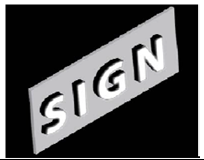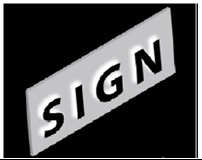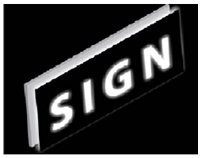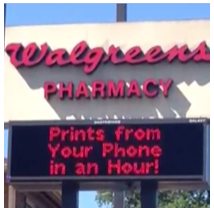19.67.040 General requirements.
A. Sign Location Restrictions. Except where specifically authorized by this chapter, signs are prohibited in the locations described below. Prohibited signs are subject to removal (except nonconforming signs as defined by this chapter) by the city at the owner’s expense.
1. Any temporary or permanent freestanding sign located within or projecting over a city right-of-way or within five feet of a city right-of-way, unless otherwise noted in this chapter.
2. Any sign attached to any public utility pole, structure or street light, tree, fence, fire hydrant, bridge, curb, sidewalk, park bench, statue, memorial, or other location on public property, except those signs approved as part of a special event permit on city property or banner signs permitted by the city on light poles in certain zones within the city. Nothing in this section must be construed to prohibit a person from holding a sign while located on public property so long as the person holding the sign is located on public property determined to be a traditional public forum and does not block ingress to and egress from buildings or create a safety hazard by impeding travel on sidewalks, bike and vehicle lanes, and trails.
3. Any sign which, by reason of its location, will obstruct the view of any authorized traffic sign, signal, or other traffic control device or which by reason of shape, color, or position interferes with or could be confused with any authorized traffic signal or device.
4. Any sign which is placed so as to prevent or inhibit free ingress to or egress from any door, window, or any exit way required by the building and/or fire code currently in effect.
5. Any commercial, advertising, or business sign that is not located on the premises of the business to which it refers.
7. No portable or temporary sign may be placed on the front or face of a building or on any premises except as authorized in AMC 19.67.110, Temporary sign standards.
8. Placement on private property for more than 10 days in any 90-day period of any truck, boat, trailer or other vehicle or vehicle part which has affixed thereto any commercial advertising message not pertaining to the legally permitted use carried on within such property is prohibited.
B. Sign Display Restrictions.
1. Purpose. The purpose of this subsection is to regulate the manner in which signs convey their messages by specifying prohibited display features that create distractions to the traveling public and create visual clutter that mars the natural and architectural aesthetics of the city.
2. Applicability. The display features described below are prohibited. Prohibited signs are subject to removal (except legal nonconforming signs as defined by this chapter) by the city at the owner’s expense.
a. Any sign or lighting device, whether on the exterior of a building or on the inside of a window which is visible beyond the boundaries of the lot or parcel, or from any public right-of-way, with intermittent, flashing, rotating, blinking or strobe light illumination.
b. Any sign with an exposed light source, except for neon incorporated into the design of the sign.
c. Any sign which emits sound, odor, smoke, laser or hologram lights, or other visible matter, including any sign that uses motion picture projection.
d. Any sign animated by any means, including fixed aerial displays, balloons, pennants, spinners, strings of flags, streamers, tubes, or other devices affected by the movement of the air or other atmospheric or mechanical means, except for:
i. Signs exempted from this chapter as established in AMC 19.67.020.
ii. Temporary signs as provided for in AMC 19.67.110.
e. Any sign in which the sign body or any portion of the sign rotates, moves up and down, or any other type of action involving a change in position of the sign body or any portion of the sign, whether by mechanical or any other means, except for signs exempted from this chapter as established in AMC 19.67.020.
f. Digital and other changeable copy signs, except as provided for in Table 19.67.040(C)(2) and AMC 19.67.080(D) for certain freestanding signs.
g. Mannequins holding a sign or displaying advertising, whether stationary or animated, except within a building as part of a window or interior display.
C. Sign Illumination.
1. General Illumination Standards.
a. Indirect sign illumination must be no further away from the sign than the height of the sign.
b. Externally illuminated signs must be arranged so that no direct rays of light are projected from such artificial source into residences, businesses or any street right-of-way.
c. External sign light fixtures must complement the design of the sign and building facades or structures associated with the sign.
d. External sign lighting must be “full cutoff” and must not result in direct illumination of the sky and adjacent properties and structures, and must be designed to minimize reflected glare to adjacent properties and structures.
2. Permitted Sign Illumination Types. Table 19.67.040(C)(2) below specifies permitted sign illumination types by zone.
|
Illumination Type |
Permitted Zones |
Other Requirements |
|
|
Channel letter. Light is emitted through the front or face of the letters. |

|
All mixed-use and industrial zones, except CBD |
May be incorporated into a permitted wall, pole, or monument sign |
|
Reverse channel letter. Letter faces are opaque and light source provides halo effect through backlighting. |

|
All mixed-use and industrial zones and the MED-O zone |
May be incorporated into a permitted wall, pole, or monument sign |
|
Push-through. Letters are cut out of opaque sign face. Interior light shines through letter faces only. |

|
All mixed-use and industrial zones and the MED-O zone |
May be incorporated into a permitted wall, pole, or monument sign |
|
Neon. |

|
All mixed-use and industrial zones |
May be incorporated into a permitted wall, projecting, window, pole, or monument sign |
|
Internally illuminated cabinet signs. Sign face is illuminated through translucent casing. This includes internally illuminated changeable copy signs. |

|
LM, LM1, MS, I and HM |
May be incorporated into a permitted wall, pole, pylon, or monument sign |
|
Digital message signage. |

|
All mixed-use and industrial zones, except CBD |
Only allowed to be integrated on permitted monument and pole signs per AMC 19.67.080(D) |
|
Internally illuminated awning signs. Awning face is illuminated through awning material. |

|
Not allowed in any zone |
|
|
Externally illuminated sign. |

|
All zones |
Illumination techniques must focus the light on the sign and avoid glare to the sky, streets, sidewalks, and other public spaces, and adjacent uses |
D. Sign Materials, Structural, and Electrical Restrictions.
1. Except flags, temporary, and portable signs, and window signs conforming in all respects with the requirements of this chapter, all signs must be constructed of durable materials and must be permanently attached to the ground, a building, or another structure by direct attachment to a rigid wall, frame, or structure.
2. All attached signs and sign support frames must be mounted and attached to a building or the ground in a secure manner and must be maintained in good repair for safety and appearance.
3. All wiring, fittings, and materials used in the construction, connection, and operation of electrically illuminated signs must be in accordance with the provisions of the National Electric Code or the local electric code in effect. All such signs require an electrical permit and inspection by the Washington State Department of Labor and Industry, Electrical Division, or equivalent inspection.
E. Sign Maintenance and Inspection.
1. Maintenance. All signs, including signs heretofore installed, must be constantly maintained in a state of security, safety, appearance and repair. If any sign is found not to be so maintained or is insecurely fastened or otherwise dangerous, it is the duty of the owner and/or occupant of the premises on which the sign is fastened to repair or remove the sign within five days after receiving notice from the Director. The premises surrounding a freestanding sign must be free and clear of rubbish and the landscaping area must be maintained.
2. Inspection. All sign owners must permit the periodic inspection of their signs by the city upon city request. (Ord. 3040 § 2 (Att. A), 2019)